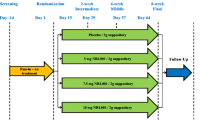Abstract
INTRODUCTION: Amitriptyline, a tricyclic antidepressant agent with anticholinergic and serotoninergic properties, has been used empirically in the treatment of idiopathic fecal incontinence with good results. METHODS: An open study was conducted to test the response to amitriptyline 20 mg daily for four weeks by 18 patients (2 males) of median age 66 years with idiopathic fecal incontinence. Incontinence scores, number of bowel movements, computerized ambulatory anorectal pressures, and pudendal nerve terminal motor latencies were evaluated before and after four weeks of therapy. Twenty-four control subjects (10 males) of median age 61 years were also assessed. RESULTS: Amitriptyline improved incontinence scores (median pretreatment score=16vs. median posttreatment score=3;P<0.001) and reduced the number of bowel movements per day (P<0.001). Amitriptyline also decreased the frequency (median pretreatment frequency=4.5 per hourvs. median immediate posttreatment frequency=1.2 per hour (P<0.05); control median frequency=0.3 per hour) and the amplitude of rectal motor complexes (median pretreatment rectal pressure=94 cm H2Ovs. median immediate posttreatment rectal pressure=58 cm H2O (P<0.05); control median rectal pressure=36 cm H2O) and improved anal pressures during these events (P<0.001). CONCLUSIONS: Amitriptyline improved symptoms in 89 percent of patients with fecal incontinence. The data support that the major change with amitriptyline is a decrease in the amplitude and frequency of rectal motor complexes. The second conclusion is that drug increases colonic transit time and leads to the formation of a firmer stool that is passed less frequently. These in combination may be the source of the improvement in continence.
Similar content being viewed by others
References
McQuay HJ, Carroll D, Glynn CJ. Low dose amitripytline in the treatment of chronic pain. Anaesthesia 1992;47:646–52.
Miller R, Bartolo DC, Locke-Edmunds JC, Mortensen NJ. Prospective study of conservative and operative treatment for fecal incontinence. Br J Surg 1988;75:101–5.
Gee AS, Durdey P. Urge incontinence of feces is a marker of severe external anal sphincter dysfunction. Br J Surg 1995;82:1179–82.
Hoffmann BA, Timmcke AE, Gathright JB Jr, Hicks TC, Opelka FG, Beck DE. Fecal seepage and soiling: a problem of rectal sensation. Dis Colon Rectum 1995;38:746–8.
Law PJ, Kamm MA, Bartram CI. Anal ultrasonography in the investigation of fecal incontinence. Br J Surg 1991;78:312–4.
Farouk R, Duthie GS, Pryde A, Bartolo DC. Abnormal transient internal sphincter relaxation in idiopathic pruritus ani: physiological evidence from ambulatory monitoring. Br J Surg 1994;81:603–6.
Farouk R, Duthie GS, Pryde A, McGregor AB, Bartolo DC. Internal anal sphincter dysfunction in neurogenic fecal incontinence. Br J Surg 1993;80:259–61.
Orkin BA, Hanson RB, Kelly KA. The rectal motor complex. J Gastrointest Motil 1989;1:5–8.
Hallgren T, Fasth S, Delbro D, Nordgren S, Oresland T, Hultén L. The effects of atropine or benzilonium on pelvic pouch and anal sphincter functions. Scand J Gastroenterol 1991;26:563–71.
Castiglione F, Daniele B, Mazzacca G. Therapeutic strategy for irritable bowel syndrome. Ital J Gastroenterol 1991;23(Suppl 1):53–5.
Ritchie JA, Truelove SC. Comparison of various treatment for irritable bowel syndrome. BMJ 1980;281:1317–9.
Farrar JT. The effects of drugs on intestinal motility. Clin Gastroenterol 1982;11:673–81.
Kumar D, Wingate DL. Colorectal motility. In: Henry MM, Swash M, eds. Coloproctology and the pelvic floor. London: Butterworth-Heinemann, 1992:72–85.
Author information
Authors and Affiliations
About this article
Cite this article
Santoro, G.A., Eitan, B.Z., Pryde, A. et al. Open study of low-dose amitriptyline in the treatment of patients with idiopathic fecal incontinence. Dis Colon Rectum 43, 1676–1681 (2000). https://doi.org/10.1007/BF02236848
Issue Date:
DOI: https://doi.org/10.1007/BF02236848




